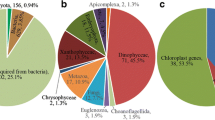Summary
Cot analysis ofChlorella DNA revealed that the genome of the unicellular green alga contained a small amount of repetitive sequences (at most 15% of the total DNA). Short repetitive sequences (SRS) of 170 bp produced by enzymatic digestion of algal DNA with eitherHaeIII,HinfI, orPstI, were found by polyacrylamide gel electrophoresis, and their copy number was estimated to be a few hundred (about 2% of the total repetitive sequences). All three members showed high sequence homology and could be be unified into one family, ‘HaeIII family’. The family was divided further into two subfamilies,HinfI- (HaeIII-andHinfI-SRS) andPstI-(PstI-SRS) subfamilies, based on small sequence differences among the members. TheHaeIII family had characteristic structural features, including a considerable number of small unique sequence units (purine-CC) and both direct and inverted repeats, and were organized in tandem arrays in the genome.
Similar content being viewed by others
References
Aoshima J, Nishimura T, Iwamura T: DNA polymerases ofChlorella. I. Chloroplastic and nuclear DNA polymerases in synchronized algal cells. Cell Struct Funct 7: 327–340, 1982.
Barnes SR, James AM, Jamieson G: The organisation, nucleotide sequence, and chromosomal distribution of a satellite DNA fromAllium cepa. Chromosoma 92: 185–192, 1985.
Brennicke A, Hemleben V: Sequence analysis of the clonedCucumis melo highly repetitive satellite DNA. Z Naturforsch 38c: 1062–1065, 1983.
Britten RJ, Graham DE, Neufeld BR: Analysis of repeating DNA sequencess by reassociation. In: Grossman EL, Moldave K (eds) Methods in Enzymology, Vol 29E. Academic Press, New York, 1974, pp 363–406.
Britten RJ, Kohne DE: Repeated sequences in DNA. Science 161: 529–540, 1968.
Cairns J: The chromosome ofE. coli. Cold Spring Harbor Symp Quant Biol 28:43–46, 1963.
Deumling B: Sequence arrangement of a highly methylated satellite DNA of a plant,Scilla: A tandemly repeated inverted repeat. Proc Natl Acad Sci USA 78: 338–342, 1981.
Flavell R: The molecular characterization and organization of plant chromosomal DNA sequences. Ann Rev Plant Physiol 31: 569–596, 1980.
Freeling M: Plant transposable elements and insertion sequences. Ann Rev Plant Physiol 35: 277–298, 1984.
Hirano H, Nishimura T, Iwamura T: High-flow-rate hydroxylapatites. Anal Biochem 150: 228–234, 1985.
Hirano H, Iguchi M, Nishimura T, Iwamura T: Isolation of high molecular weight cellular DNA with a novel granulated hydroxylapatite. Agric Biol Chem 50: 219–221, 1986.
Iwamura T, Katoh K, Nishimura T: Semi-conservative replication of chloroplast DNA in synchronizedChlorella. Cell Struct Funct 7: 71–86, 1982.
Iwamura T, Kuwashima S: Further observations on the deoxyribo-nucleic acid species inChlorella showing light-dependent metabolic turnover. Biochim Biophys Acta 82: 678–679, 1964.
Lederberg EM, Cohen SN: Transformation ofSalmonella typhimurium by plasmid deoxyribonucleic acid. J Bact 119: 1072–1074, 1974.
Leutwiler LS, Hough-Evans BR, Meyerowitz EM: The DNA ofArabidopsis thaliana. Mol Gen Genet 194: 15–23, 1984.
Maniatis T, Fritsch EF, Sambrook J: Molecular Cloning. Cold Spring Harbor Laboratory, 1982.
Maxam AM, Gilbert W: Sequencing end-labeled DNA with base-specific chemical cleavages. In: Grossman L, Moldave K (eds) Methods in Enzymology, Vol. 65. Academic Press, New York, 1980, 499–560.
Peacock WJ, Dennis ES, Rhoades MM, Pryor AJ: Highly repeated DNA sequence limited to knob heterochromatin in maize. Proc Natl Acad Sci USA 78: 4490–4494, 1981.
Takabayashi A, Nishimura T, Iwamura T: Incorporation of radioactive tracers of some labelled compounds into DNA, RNA and protein inChlorella cells at various stages of the cell cycle in synchronous culture. J Gen Appl Microbiol 22: 183–196, 1976.
Yakura K, Kato A, Tanifuji S: Length heterogeneity of the large spacer ofVicia faba rDNA is due to the differing number of a 325 bp repetitive sequence elements. Mol Gen Genet 193: 400–405, 1984.
Author information
Authors and Affiliations
Rights and permissions
About this article
Cite this article
Hirano, H., Takeda, Y. & Iwamura, T. Unique repetitive sequences of 170 bp inChlorella . Plant Mol Biol 7, 311–317 (1986). https://doi.org/10.1007/BF00752903
Received:
Revised:
Accepted:
Issue Date:
DOI: https://doi.org/10.1007/BF00752903




